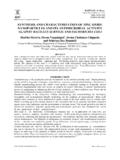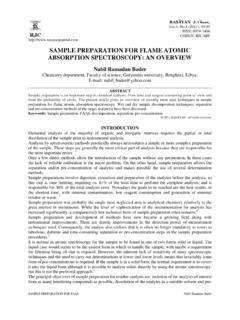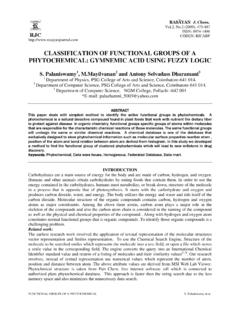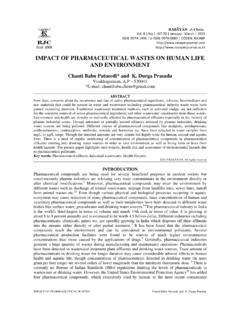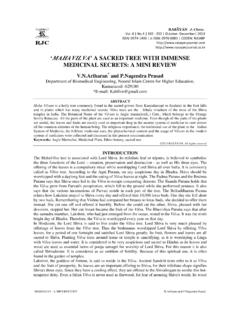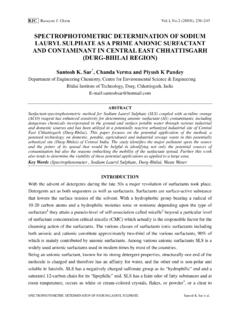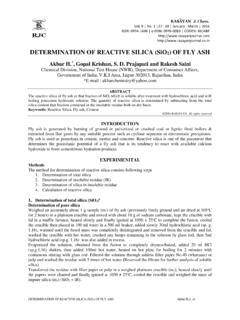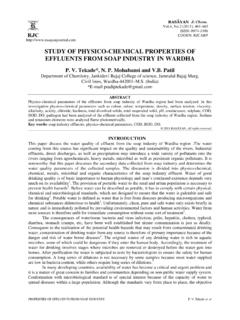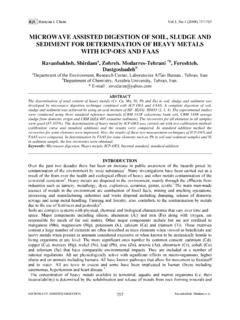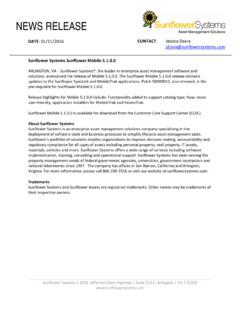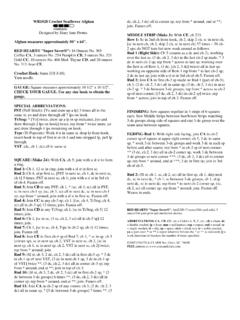Transcription of PHYTOEXTRACTION OF LEAD FROM INDUSTRIAL …
1 , (2011), 8-12. ISSN: 0974-1496. CODEN: RJCABP. PHYTOEXTRACTION OF LEAD FROM INDUSTRIAL . EFFLUENTS BY SUNFLOWER (HELIANTHUS ). R. Usha*, A. Vasavi, K. Thishya, Rani and Department of Biotechnology, Sri Padmavathi Mahila Visvavidyalayam, Tirupati 517 502, Andhra Pradesh, INDIA. *E-mail: ABSTRACT. PHYTOEXTRACTION is an emerging cost-effective solution for remediation of contaminated soils which involves the removal of toxins especially Heavy metals by roots of the plants with subsequent transport to aerial plant organs. In the present investigation, the phytotoxicity of lead on growing sunflower (Helianthus annuus .L) was studied. The plants were exposed to 5, 10,15,20,25 and 30 ppm of effluent water for a period of 1,2,3,4 & 5 weeks. The extent of damage to chlorophyll, plant height, plant width, dry weight, fresh weight was evaluated. This is a preliminary study to develop a method for treating INDUSTRIAL waters that are contaminated with lead.
2 Lead uptake by sunflower was monitored by Atomic Absorption Spectroscopy (AAS) Maximum accumulation of Heavy metals was found in root than leaf and stem. The Physical ,Biological parameters along with metal accumulation in plants was found to be increased with increase in concentration of effluent water up to 15 ppm followed by decline with high dosage of metal concentration. Key words: PHYTOEXTRACTION , Phyto toxicity, Heavy metal, Lead and AAS. 2011 RAS YAN. All rights reserved. INTRODUCTION. A tremendous increase in human population and the rapid race of industrialization in India have created numerous problems of waste disposal and fresh water contamination mainly in last few decades. According to World Health Organization in developing countries 80% of the total sewage and INDUSTRIAL effluents get mixed untreated into fresh water resources.
3 Pulp and paper, sugar distilleries, fertilizers, tanneries, textiles, petrochemicals and battery based industries are mainly responsible whose effluents contributes to the contamination of fresh water resources in India. Seven crores of people depend upon drinking water with the excess of other metals like Cr, Ni, Pb and Cd etc1-2. During the last decades, heavy metals become common contaminants worldwide. The main metals concerned are cadmium (cd), Lead (pb), Zinc (Zn), Copper (Cu), Nickel (Ni), Mercury (Hg) and metalloid Arsenic (As). In contrast to the organic contaminants which can undergo biodegradation, heavy metals remain in the environment. Long term deposition of metals in soil can lead to accumulation, transport and biotoxicity caused by mobility and bioavailability of significant fraction of the metals. As a result an annual world wide release of heavy metals reached 22,000 t (metric tons) for cadmium, 939000 t for copper, 783000 t for lead and 1,350,000 t for zinc.
4 Heavy metal pollution in the environment shows deleterious effect on human health via food chain. In higher concentration these heavy metal cause severe damage to plants conventional site decontamination techniques, phytoremediation is an in-situ emerging technology based on the use of green plants to remove pollutants from the environment. PHYTOEXTRACTION will be more economically feasible which produce more biomass with an added economical value. Heavy metals like Cu,Zn have known functions as micronutrients in plants 2but metals like lead were not used as micro nutrients .So their presence at low concentrations (or) high concentrations becomes toxic to the environment. High accumulation of metals effect both growth and metabolism of plants. These phytotoxic effects of heavy metals depend on metal concentration, plant species pH and other factors in soil 5-6.
5 PHYTOEXTRACTION of Lead R. Usha et al. , (2011), 8-12. Lead (Pb) is a major anthropogenic pollutant that has been released to the environment since the INDUSTRIAL revolution and accumulated in different terrestrial and aquatic is an extremely toxic metal whose effects on human health have been widely described. Lead at 500 ppm in soil (or) solid waste considered the substance as hazardous waste .Maximum allowable level of lead in drinking water is ppm. Excessive Lead exposure can cause mental retardation and behavioral disorder and its exposure can occur through multiple pathways, through inhalation of air, soil (or) dust, as it is emitted in the environment from vehicles and automobiles. It can also enter the food chain via plants. Thus lead contamination is extremely dangerous, and lead polluted waters need to be cleansed. Thus the sunflower would probably have high tolerance and should be capable of removing large amounts of lead.
6 The present study was aimed to explore the uptake of lead (Pb) in INDUSTRIAL waste water by sunflower plants to find tolerance limit to metal concentration, growth and biochemical changes in sunflower plants. EXPERIMENTAL. The experiment was designed to study the heavy metal accumulation, growth and biochemical responses of sunflower (Helianthus ) grown in soil contaminated by INDUSTRIAL effluent. The collected soil was air dried, sieved and used for the experiment. The seeds of sunflower were obtained from hybrid seed centers. Seeds were surface sterilized with sodium hypochlorite solution for 10 minutes and rinsed with double distilled water .Seeds were grown in earthen pots (30x25 cm) containing red soil and sand 3:1 proportion. The pots were kept under natural photo radiation and each pot contained 10 seedlings .The seeds were treated with distilled water up to 7 days.
7 After one week the plants were treated with six different concentrations of effluent water viz.,5,10,15,20,25,30 ppm in separate pots till the growth of crop was observed. Analysis was made after 1, 2, 3, 4, and 5th week of treatment. The solutions used for the treatment were 500ml for each pot. The soil pH was maintained around plants were treated with six different effluent concentrations once in two days with above solutions. The plants were uprooted carefully and were washed with distilled water and then macerated using mortar and pestle for biological and metal analysis. Plant length and Plant width Plant length was measured at weekly intervals. The plants were removed carefully with root system and washed thoroughly. The length of shoot and root was measured by meter scale. The width of plants was also measured by meter scale. Seedlings were measured for plant height every week and visual symptoms of metal toxicity were assessed three times per week.
8 Estimation of Chlorophyll Levels The Chlorophyll content was estimated according to the method of Arnon (1949). About 1 gm of leaf sample was cut into small pieces and homogenized in a pre-cooled mortar and pestle using 80% (v/v). acetone. The extract was centrifuged at 3000 rpm for 15 min and made up to 25 ml with 80% (v/v). clear solution was transferred and the optical density was measured at 645 nm and 663 nm against blank in Shimadzu double beam spectrophotometer (UV 240). Total chlorophyll ( g/ml) = ( at 645 nm) + ( at 663 nm). Plant harvest and metal analysis After every 7 days of effluent treatment, plants were harvested and separated into shoots, roots and leaves and weighed for fresh weight. Then plant material was dried at 80 C for 48 hrs until constant dry weight was obtained, subsequently weighed and ground by mortar and pestle.
9 The powdered plant samples were digested with 5ml di acid mixture (Nitric acid, per chloric acid in the ratio of 3:2 at 110 C for 8 hrs. Metal content was determined by flame atomic absorption spectrometry (Perkin Elmer 2380). Effluent water analysis An effluent sample was collected from outlets of the industry (a battery manufacturing unit). The effluent sample was collected in well cleaned polythene bottle. After filtering the effluent sample, the pH of the sample was immediately measured in the laboratory and later and later the samples were stored at 4 C for further analysis. PHYTOEXTRACTION of Lead 9 R. Usha et al. , (2011), 8-12. RESULTS AND DISCUSSION. The primary point of entry for metals into plants is through the roots. However for an efficient metal removal from the soil, the metals must be translocated to the harvestable parts of shoots.)
10 The aim was to assess a potentiality of sunflower plants for metal accumulation. Excess of trace elements as well as uptake of non-essential can lead to toxic effects on plant growth. The uptake of metals is frequently related to their concentrations in soil. 9 have investigated the localization of lead in root tissue. Lead was found in the basal part deposited mostly in the cell walls adjacent to the plasma membrane and the endomembrane compartment. There are several possible areas through which lead can penetrate into plants. However, it is understood that roots are the main pathway through which trace metal enter into plant body. It was determined that in plants, metal uptake at first stops on root surface and then a portion of ions which penetrate into roots is bound in cell walls and the rest is accumulated in the intercellular was determined that in the sunflower plants, roots are the main accumulation on site of lead, because there are severally affected by lead concentration in the medium.
